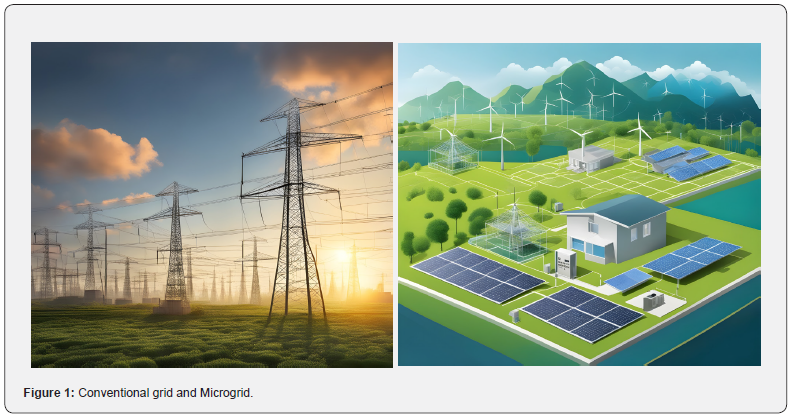Application of Artificial Intelligence in Microgrid Integration
Ila Rai*
Alliance College of Applied Engineering, Alliance University, Karnataka, India
Submission: October 6, 2023;Published: February 14, 2024
*Corresponding author:Ila Rai, Alliance College of Applied Engineering, Alliance University, Karnataka, India
How to cite this article:Ila Rai. Application of Artificial Intelligence in Microgrid Integration. Eng Technol Open Acc 2024; 5(5): 555673. DOI: 10.19080/ETOAJ.2024.05.555673
Abstract
Two lesser-known properties for coupled semiconductor diode lasers are discussed. The first one is the gain dependence of the coupling coefficient, introducing the need of self-consistency; the other is the crucial role of the coupler phase, e.g., the argument of the coupling coefficient, for stable locked operation.
Keywords:Semiconductor Diode Laser; Coupled Lasers; Locking
Opinion Article
A need for alternative energy sources has arisen due to the adverse effects caused over time by using fossil fuel-fueled power plants to produce electricity. One of the worst of these issues, global warming, which results in numerous climate changes, is one of several that the world is currently experiencing due to using conventional energy sources. As a result of the widespread concern over environmental contamination and the continuous depletion of conventional energy sources, there is a trend to rely on renewable energy sources (RES) rather than conventional sources. As opposed to conventional sources, RESs produce clean energy without adverse environmental effects. Additionally, using renewable energy sources (RESs) has grown more appealing for supplying electricity to rural and isolated areas, improving the system’s dependability and sustainability significantly when extending electricity is challenging. Therefore, microgrids based on renewable energy source concepts have become a popular alternative in recent years because they use RESs, which are environmentally friendly. A microgrid comprises RESs and energy storage systems (ESSs), including various loads. The essential characteristic that sets microgrids apart from other distribution networks is their capacity to function in an islanded mode.
Both consumers and utilities benefit greatly from microgrids. The majority of these benefits include increased reliability due to the community layer distribution network’s flexibility, improved power quality due to the management of flexible loads, reduced carbon emissions due to the variety of RESs, decreased transmission and distribution losses, cheap energy supply using more renewable resources, and the opportunity to participate in the energy markets actively.
Since a substantial portion of RESs are stochastic, there is a lot of uncertainty and a variety of situations where effective microgrid network control is crucial. To accommodate and enhance the performance of the numerous RESs, it may be beneficial to interconnect several microgrids as a network of microgrids. A network of interconnected microgrids can be a practical way to accommodate and enhance the performance of the many RESs. Additionally, it has been proven that by connecting many geographically adjacent microgrids via a distribution line to create a networked microgrid, the reliability and flexibility of the connected microgrid can be significantly improved. However, the integration of various RESs is subject to numerous challenges due to the intermittent and unpredictable character of RESs.
Advanced microgrids control various factors to generate the cleanest, most reliable, and most efficient electricity possible. Even under the best-case scenario, a grid-connected microgrid may need to sort through enormous amounts of data, including meteorological conditions, shifting energy production and consumption patterns, and constantly changing fuel and electricity prices. Additionally, microgrids are responsible for controlling the high fluctuation of renewable energy as we progressively work to fulfill climate targets with renewable energy.
More data is needed to accurately forecast short-term production and consumption in today’s complex microgrids. It is essential to have a sophisticated artificial intelligence system that can automatically understand the local context before providing a forecast (Figure 1).

AI, especially when working with massive data sets, can solve issues, identify patterns and iterations, and make conclusions that would otherwise be difficult for a human mind to precisely compute. Big data, the cloud, and AI have combined to process enormous amounts of data and “learn” patterns from the data to correctly deduce conclusions. AI provides quick computing for real-time modelling of enormous amounts of data for microgrid developers, assisting them in capacity sizing choices regarding grid equipment, solar and wind configurations, and utilisation of electric vehicle charging infrastructure.
Furthermore, the efficient utilisation of controllers, solar inverters, battery systems, and other distributed energy grid resources can be enabled through modelling and simulation using artificial intelligence. Energy can be automatically distributed at the appropriate cost, location, and time without the involvement of human decision-makers or lever-pullers.
Industries, neighbourhoods, organisations, lawmakers, and military organisations depend more and more on autonomous microgrids as they work to decrease carbon emissions, lower energy costs, and improve energy reliability. Microgrids may move forward with these objectives more quickly, easily, and autonomously by utilising AI based real-time technology. With the use of AI, microgrids may operate more quickly and accurately while delivering consistent electrical power, optimising load, seizing market opportunities, and managing the fluctuation of renewable energy sources.
Microgrids and AI were once thought to be futuristic technologies. But it’s becoming obvious that they are a realistic, strategic approach, driven by the pandemic. Many businesses are prepared to put their faith in AI and are currently thinking about intelligent microgrid systems to increase resilience during recovery and safeguard their operations from potential disruptions.






























